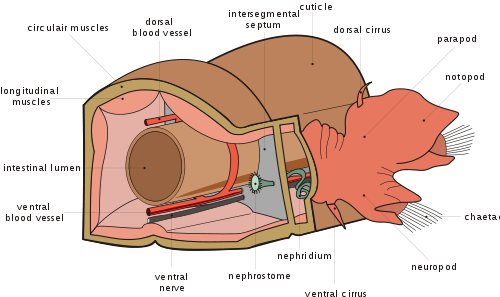Internal Anatomy

Internal anatomy of a Polychaete.
Image found on Wikipedia, search under Polychaete.
The Christmas tree worm utilizes a hemal and coelomic internal transport system. As they use both of these systems, nephridia are used in excretion of waste. The circular muscles are located outside of the longitudinal muscles to allow for peristalitic movement. Each segment is separated by a septum, ensuring each of the coelomic cavities do not mix. The hemal system compensates for this segmentation of the body by transporting the nutrients, oxygen and waste between each part. The body is lined with a cuticle to help protect the worm from external harm, although this is reduced in burrowing polychates such as the Christmas tree worm as is it not required. The worm possesses a U-shaped gut, with the anus located at the base of the tentacle whorl.
|